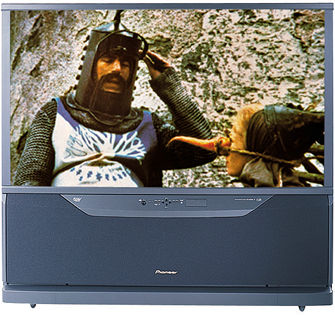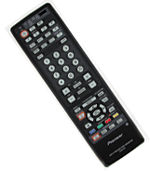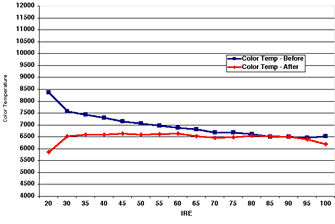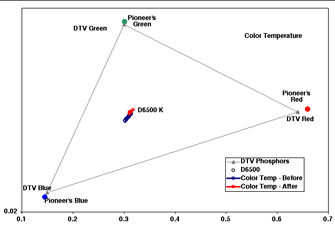The Monster TV Face Off Pioneer SD-643HD5
The SD-643HD5 is one of Pioneer's least expensive displays. Only the 53-inch model requires fewer dollars (or less credit, as the case may be). Yet, at $5,300, the Pioneer set is the most expensive display in our Face Off, so it was with much protest that we allowed it to participate. The price cap was supposed to be $5,000, and that was only because the Sony display included an HDTV tuner. Most of the other displays came in around $3,500 to $4,000. The Pioneer set doesn't even include a digital tuner; if it did, that would bump the cost even higher. Then again, I found the set at some local retailers for $4,000.

Add a line item for an A/V receiver or external switcher to that budget, as the SD-643HD5 has a limited input panel. The back-panel arrangement is odd: Many of the connectors, which are shared for particular inputs, are spread out all over the place. Fortunately, the remote control offers direct access to each of these inputs. The remote's buttons are arranged better and glow in the dark, which is nice, but the remote is big, square, and not incredibly comfortable. The onscreen menu is equally clunky, with big, blocky graphics, but it gets the job done easily and effectively.
 Considering its lack of input flexibility, the Pioneer set certainly offers numerous picture adjustments. In addition to the regular controls, you can change the color-decoder and DC-restoration accuracy and even disable the SVM. This will produce an enhanced image that will seem bright and punchy during the day and yet still create a more-naturally hued image with better black-level stability and more real image detail when watching movies.
Considering its lack of input flexibility, the Pioneer set certainly offers numerous picture adjustments. In addition to the regular controls, you can change the color-decoder and DC-restoration accuracy and even disable the SVM. This will produce an enhanced image that will seem bright and punchy during the day and yet still create a more-naturally hued image with better black-level stability and more real image detail when watching movies.
 These functions, combined with a reasonably accurate factory color-temperature setting, helped propel the Pioneer to the top of the heap in the Face Off. In fact, the Pioneer was carried from the first round to the last, winning out over the competition in each round. Adrienne liked the set's more-accurate black level, while Big Papa favored the excellent internal line doubler. This was the only set that made a noticeable impact on the Video Essentials 3:2 zone-plate test. The TV almost eliminated the 3:2-pulldown-induced artifacts that were very noticeable on some of the other displays. Only some minor scaling artifacts seemed to persist. Mr. HD liked the Pioneer's HD image and felt that the display had great colorimetry (i.e., accurate colors), as compared with the reference monitor. He had a slight preference for the Hitachi set in the second round but went with the Pioneer in the end. While the Kid cast his final vote for the Toshiba display's slightly sharper picture, C Dogg summed it up best when she said that this TV just did really well in every aspect of performance.
These functions, combined with a reasonably accurate factory color-temperature setting, helped propel the Pioneer to the top of the heap in the Face Off. In fact, the Pioneer was carried from the first round to the last, winning out over the competition in each round. Adrienne liked the set's more-accurate black level, while Big Papa favored the excellent internal line doubler. This was the only set that made a noticeable impact on the Video Essentials 3:2 zone-plate test. The TV almost eliminated the 3:2-pulldown-induced artifacts that were very noticeable on some of the other displays. Only some minor scaling artifacts seemed to persist. Mr. HD liked the Pioneer's HD image and felt that the display had great colorimetry (i.e., accurate colors), as compared with the reference monitor. He had a slight preference for the Hitachi set in the second round but went with the Pioneer in the end. While the Kid cast his final vote for the Toshiba display's slightly sharper picture, C Dogg summed it up best when she said that this TV just did really well in every aspect of performance.
Most of the judging panel agreed that the final round, in which the Pioneer competed against displays from Toshiba, Sharp, and Zenith, was the toughest and that choosing the Pioneer as a winner wasn't necessarily easy. Nearly everyone did pick it, though, and with good reason. It has a great picture. It's certainly worth noting that some of the other displays may be nearly as good for less money or may offer more upgrade options in the future. However, if you're looking for a great picture that works with current technology and can find the set at a good price, the SD-643HD5 is hard to beat.—MW
SD-643HD5 HD Monitor $5,300
Pioneer Electronics
(800) PIONEER
www.pioneerelectronics.com
Dealer Locator Code PIO

HT Labs Measures:Pioneer HD Monitor


The top chart shows the gray scale of the Pioneer HD monitor as set by the manufacturer, in the most accurate menu setting possible. The set measures around 7,500 Kelvin with dark images and leans to an accurate 6,500 K with brighter images. After making adjustments using the Photo Research PR-650, the gray scale measures within 150 K of D6500, the accurate setting, across the entire range. The bottom chart shows that the primary colors of the display's CRTs are excellent, matching those specified by SMPTE. This means that the display will reproduce all of the colors available in the system. The gray scale, shown in the middle of the triangle, goes from tinting the image slightly red before calibration to being very accurate (the middle red dots) afterward. The light output was approximately 30 foot-lamberts with a white window and about 29 ft-L afterwards, which means the set has a good power supply. The display has decent DC restoration: Dark portions of the image get slightly darker as the image gets brighter. Both scan velocity modulation and color-decoder accuracy can be adjusted, with good results, from the user menu. The TV displays at least 450 horizontal lines (per picture height) with NTSC sources, as measured using the resolution pattern from the Ovation Avia test DVD played on a Sony CDP-650D DVD player.—MW/GM
- Log in or register to post comments
























































